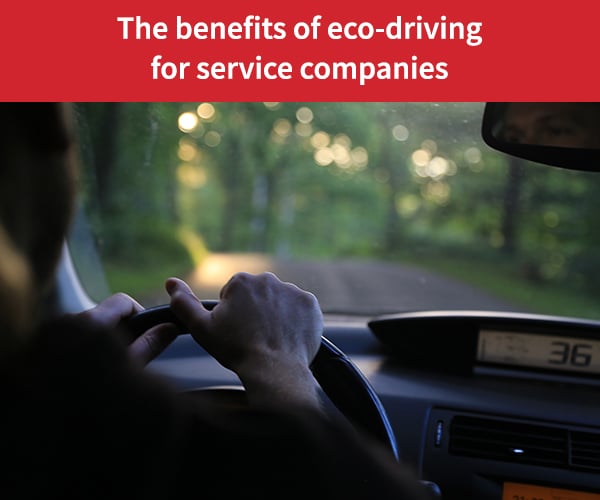
- Field Service Management
- Mobility
- Software
- Technician
Field service management: why maintenance technicians need to learn eco-driving
For service companies with field technicians, the economics of optimising routes and eco-driving can quickly become significant. With a business strategy built around eco-driving, service companies can achieve real savings and strengthen the company’s brand image on environmental issues, which are increasingly important today.
Eco-driving reduces fuel consumption and CO2 emissions
Before we get into the benefits of eco-driving for service companies, we need to define what eco-driving is. In most cases, field service professionals are not yet fully aware the problem exists or the issues associated with it. Put simply, eco-driving is about anticipating and optimising technicians’ behaviours when they’re behind the wheel of their service vehicle. The goal is to minimise braking and acceleration to maintain a constant speed throughout as much of the journey as possible. This approach results in low engine speeds that reduce fuel consumption and CO2 emissions. We’re talking about eco-driving in terms of the savings it enables for companies, but it’s actually economical driving. And the benefits are considerable. According to Transport and Environment Reporting Mechanism (TERM) indicators published by the European Environment Agency, eco-driving significantly improves the safety of technicians behind the wheel by reducing their accident rate by 10 to 15%. In addition, average fuel consumption is reduced by about 15%. According to the TERM figures, this can represent a savings of up to 500 euros (about $775 CAD) per driver per year. And that’s not to mention maintenance costs, which are also reduced. Because drivers aren’t pushing vehicles so hard, the vehicles hold up longer on the road. Finally, the European Environment Agency TERM indicators also confirm that eco-driving helps to limit the greenhouse gases responsible for global warming.
Service companies with an eco-driving strategy gain key benefits
There are several reasons for service companies to implement an eco-driving strategy.
Improve technicians’ safety while they’re on the road
Technician safety is a priority for service companies. However, not enough of them are drawing employee attention to road risks. Yet, road accidents are responsible for more than 50% of workplace fatalities. Service companies that train employees and encourage them to adopt economical driving have a good chance of lowering vehicle loss rates.
Reduce fuel costs by up to 25%
The second advantage of eco-driving is lower fuel consumption. By driving at a more constant speed and limiting acceleration and braking, drivers can help to reduce their company’s fuel costs. The Enterprise Vehicle Observatory in France estimates that eco-driving can achieve fuel savings of up to 25%.
Optimise vehicle maintenance schedules
Well-maintained vehicles consume less and are less likely to break down. They also improve driver safety. Switching to smoother driving through eco-driving reduces strain on vehicles. It also helps keep vehicles in good condition. Beyond maintenance, eco-driving makes the driver responsible for road risk. As mentioned, road accidents are the main causes of workplace fatalities. Smoother and more proactive driving helps to reduce the number of traffic accidents. Although there’s no official number, there’s often talk of a 10 to 15% drop in accidents. That means service company can play a key role in mitigating road risks and benefit from fewer claims against its fleet.
Reduce the environmental impact of the vehicle fleet
Cars with internal combustion engines generate CO2 emissions. This impact on the environment can affect the company’s brand image. Service companies that offer eco-driving to employees can help reduce their CO2 emissions by up to 25%.
Implementing an eco-driving strategy
For service companies to successfully implement an eco-driving strategy, technicians must buy-in to the project. To gain their support, they must be made aware of the issue, properly trained, encouraged and motivated to adopt good practices.
Raise awareness among mobile maintenance technicians
For full adoption of a company’s eco-driving initiative, employees must understand and participate in the project. After all, it’s technicians who drive dozens of kilometres every day to get from one service site to another. Nothing will happen unless they’re convinced the process has value. If you can get technicians’ support, the project results will be much better, and the benefits will quickly be both visible and concrete. To get this support, it’s important to clearly explain to drivers what eco-driving is and what the benefits are. It’s also a good opportunity to remind drivers that eco-driving also helps protect their safety and well-being at work.
Teach eco-driving
Companies that want their mobile technicians to adopt eco-driving can choose from among several different training options. While training costs money, it also saves money, for example, by making it possible to negotiate better insurance rates for vehicle fleets. Eco-driving is also a good way to increase driver awareness beyond corporate messaging. Employees have a direct connection with the issues related to their driving experiences and the benefits of eco-driving.
Set up internal eco-driving challenges
Once a company has adopted eco-driving and employees are informed and trained, it’s important to bring the initiative to life on a daily basis. On-board telematics solutions, such as those from the French company, Ocean, can be used to support the initiative. Ocean offers on-board solutions and actively collaborates with car manufacturers to offer long-term monitoring of eco-driving initiatives, using indicators and dashboards that are tied to a smartphone application. The information helps companies:
- Manage driver time on the road and driving behaviour (manage driver deviations with ratings)
- Monitor CO2 emissions and fuel consumption
- Manage vehicle maintenance
Setting up competitions and challenges around eco-driving can also be a good way to keep the fire burning.
Optimise travel times for service technicians
One of the technical prerequisites for executing on an eco-driving strategy is to deploy a field service management solution. Companies that still manage field technicians using paper files and Excel spreadsheets will have a hard time achieving the organisational flexibility and complete perspective needed to effectively manage employees’ movements in the field. Field service management software provides several operational advantages to address these challenges:
- The route planning interface allows technicians’ schedules to be developed in the most efficient and realistic way possible.
- Customer locations and technicians’ locations can be taken into account in real time when coordinating and arranging service calls. Then, field service management software, such as the software offered by Praxedo, can be used to consider travel times between sites.
- In addition, with the right scheduling tool, technicians’ service calls can be prioritized based on the situation in the field. This makes it easy to add an urgent service call to the schedule and to shift an assignment from one technician to another if a technician falls behind and another technician is available to jump in and get the job done faster.
Regularly share good practices and information
It’s important to regularly remind drivers about the importance of eco-driving and the overall benefits for the fleet. This helps make the results more concrete for them. If drivers help to reduce losses for the company’s fleet by changing their behaviour, that fact needs to be known. Appreciating employee success is essential for success.
Our similar articles.
-
- Technician
- Productivity
How to get the best from your broadband engineer teams
November 9, 2022 -
- Field Service Management
- Software
- Cloud
- Work orders
The booming global market for field service management in the cloud
March 12, 2018 -
- Field Service Management
- Software
Gain efficiencies in facility management with field service technology
November 16, 2021


